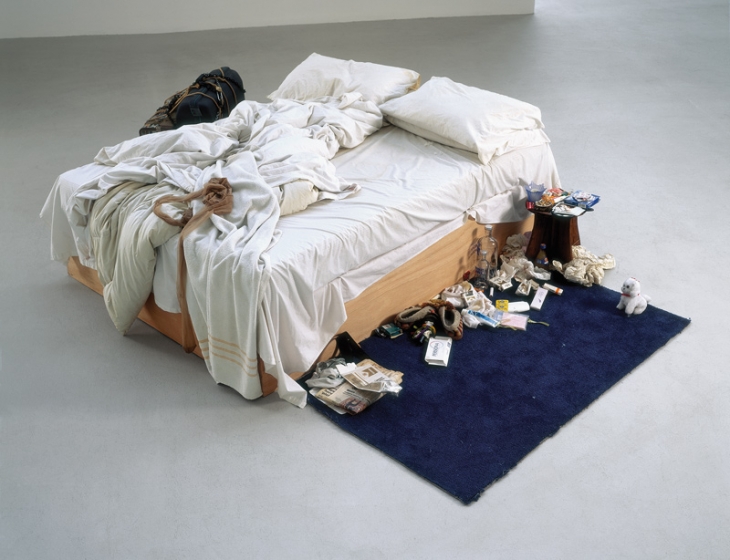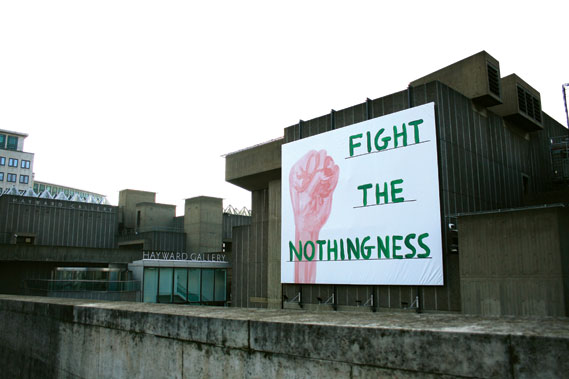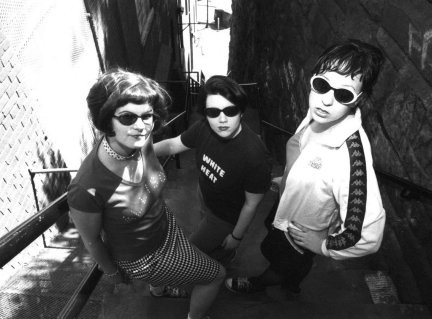- how is modern conceptual art perceived by the public?
research -> gathering quotes
INSIDE THE WHITE CUBE: THE IDEOLOGY OF THE GALLERY SPACE
by Brian O'Doherty
- "we have reached a point where we see not the art but the space first" p.14
- "the ideal gallery subtracts from the artwork all cues that interfere with the fact that it is "art". The work is isolated from everything that would detract from its own evaluation of itself. This gives the space a presence possessed by other spaces where conventions are preserved through the repetition of a closed system of values." p.14
- "things become art in a space where powerful ideas about art focus on them" p.14
- describes the modernist thinking as "ideas are more interesting than art" … "as modernism gets older, context becomes content" p.14 (a) + p.15 (b)
- describing the clinicalness of art galleries he goes on to say "in this context a standing ashtray becomes almost a sacred object, just as the firehose in a modern museum looks not like a firehose but an aesthetic conundrum" p.15
- "art exists in a kind of eternity in display and though there is lots of period (late modern) there is no time. This eternity gives the gallery a limbo like status; one has to have died to already be there" p.15
- "the space offers the thought that while eyes and minds are welcome, space-occupying bodies are not- or are tolerated as kinaesthetic mannequins for further study" p.15
- "the stability of the frame is as necessary as an oxygen tank to a diver. Its limiting security completely defines the experience within… there is no suggestion that the space within the picture is continuous with the sapece on either side of it" p.18 (ABOUT OLD, FRAMED ART)
- "through the fifties and sixties we notice the codification of a new theme as it evolves into consciousness: How much space should a work of art have (as the phrase went) to breathe? If paintings implicitly declare their own terms of occupancy, the somewhat aggrieved muttering between them becomes harder to ignore… all this traffic across the wall made it a far from neutral -zone" p.27
- "The picture plane, like an exclusive country club, keeps reality out and for good reason. Snobbishness is, after all, a form of purity, prejudice a way of being consistent. Reality does not conform to the rules of etiquette, subscribe to exclusive values, or wear a tie; it has a vulgar set of relations and is frequently seen slumming among the senses with other antithetical arts" p.38
- "… contrary to the modern myth that art is 'useless'. If art as any cultural reference (apart from being 'culture') surely it is in the definition of space and time. The flow of energy between concepts of space articulated through the artwork is one of the basic and least understood forces in Modernism. Modernist space redefines the observer's status, tinkers with his self-image. Modernism's conception of space, not its subject matter, may be what the public rightly conceives as threatening." p.38
- "as we move around that space, looking at the walls, avoiding things on the floor, we become aware that the gallery also contains a wandering phantom frequently mentioned in avant-garde dispatches- the Spectator" p.39
- ("He" being the spectator) "he frequently watches his own image chopped up and recycled by a variety of media. Art conjugates him, but he is a sluggish verb." O'Doherty then describes how the spectator sees himself in the art but is confused that he can be so much. p.41
- on installation photos / shots "the Eye is the only inhabitant of the sanitised installation shot. The Spectator is not present." p.42
- "the spectator in a tableau somehow feels like he should not be there. Segal's art makes this clearer than anyone else's. His objects- great lumps of them- wear a history of previous occupancy… their familiarity is distanced by the gallery context" p.49
- "hostility to the audience is one of the key co-ordinates of Modernism, and artists may be classified according to its wit, style and depth… this hostility is far from trivial or self-indulgent, though it has been both. For through it is waged an ideological conflict about values … each party- audience and artist- is not quite free to break certain taboos. The audience can't get mad… its anger must be sublimated, already a kind of proto-appreciation. By cultivating an audience through hostility, the (74) avant-garde gave it the opportunity to transcend insult… and exercise revenge" p.73-74
- "at its most serious, the artist/audience relation can be seen as a testing of the social order … by the support systems- galleries, museums, collectors even magazines and house critics… the main medium of this absorption is style, a stabilising construct if there ever was one" p.74
AESTHETIC THEORY
by Adorno
- "all efforts to restore art by giving it a social function- of which art is itself uncertain and by which it expresses its own uncertainty- are doomed" p.1
- "artworks detach themselves from the empirical world and bring forth another world, one opposed to the empirical world as if this other world too were an autonomous identity. Thus however tragic they appear, artworks tend a priori toward affirmation" p.2
- "the belief that the first artworks are the highest and purest is warmed over-romanticism" p.2
- "art is the social antithesis of society, not directly deducible from it" p.9
- "what popular consciousness and a complaisant aesthetics regard as the taking pleasure in art, modelled on real enjoyment, probably does not exist… whoever concretely enjoys artwork is a philistine… yet if the last traces of pleasure were extirpated, the question of what artworks stood for would be an embarrassment. Actually the more they are understood, the less they are enjoyed." p.15
- "even the traditional attitude to the artwork… was that of admiration that the works exist as they do in themselves and not for the sake of the observer." p.15
- "the relation to art was not that of its physical devouring; on the contrary, the beholder just disappeared into the material; this is even more so for modern works" p.15
- "for him who has a genuine relationship to art, in which he himself vanishes, art is not an object; (16) deprivation of art would be unbearable for him, yet he does not consider individual works sources of joy. Incontestably, no one would devote himself to art without- as the bourgeois put it- getting something out of it" p.15-16
- "the fetishistic idea of the artwork as property that can be possessed and destroyed by reflection has its exact correlative in the idea of exploitable property within the psychological economy of the self… yet precisely because they are sacred they were not objects of enjoyment" p.16
- "the concept of artistic enjoyment was a bad compromise between the social and the socially critical essence of the art work. If art is useless for the business of self-preservation- bourgeois society never quite forgives that- it should at least demonstrate a sort of use-value modelled on sensual pleasure." p.17
- "the harmonistic view of the ugly was voided in modern art, and something qualitatively new emerged" p.61
- "the impression of the ugliness of technology and industrial landscapes cannot be adequately explained in formal terms, and aesthetically well-integrated functional forms, in Adolf Loos's sense, would probably leave the impression of ugliness unchanged. The impression of ugliness stems from the principle of violence and destruction" p.61
- "the concept of the ugly may well have originated in the separation of art from its archaic phase" p.62
- "the more art is dominated throughout by subjectivity and must show itself to be irreconcilable with everything pre established, the more that subjective reason- the formal principle itself- becomes the canon of aesthetics" p.63
- "the price art has to pay for raising itself above the domination of natural powers only in order to perpetuate them as domination over nature and human beings" p.63
INSTITUTIONAL CRITIQUE AND AFTER
by several different authors
ALL THE ART THAT'S FIT TO SHOW
by Hans Haacke 1974
- "products which are considered 'works of art' have been singled out as culturally significant objects by those who, at any given time and social stratum, wield the power to confer the predicate 'work of art' onto them; they cannot elevate themselves from the host of man-made objects simply on the basis of some inherent qualities… museums and art institutions belong to that group of agents" p.53
- "a museum is a carrier of socio-political connotations… the question of private or public funding of the institution does not affect this axiom" p.53
- "'artists', as much as their supporters and enemies, no matter of what ideological coloration, are unwitting partners in the art syndrome, and relate to each other dialectically. They participate jointly in the maintenance and/or development of the ideological make-up of their society. They work within that frame, set the frame, and are being framed." p.55
WHAT IS AN INSTITUTION?
by John R. Searle
- "a status function must be represented as existing in order to exist at all, and language or symbolism of some kind provides the means of representation" p.36






































